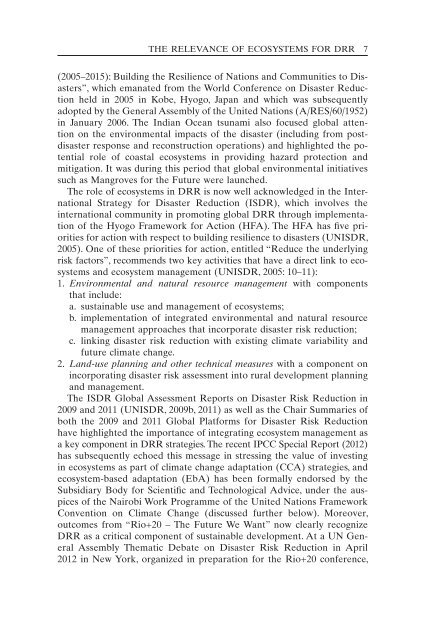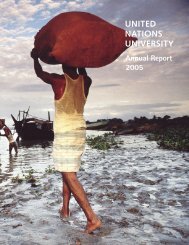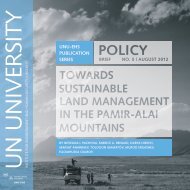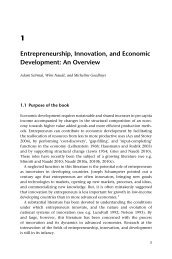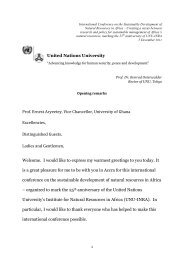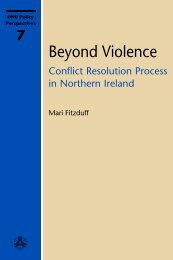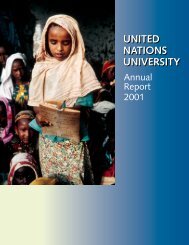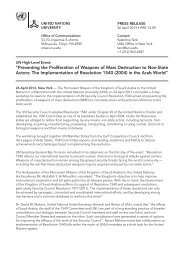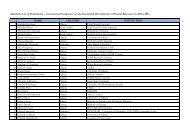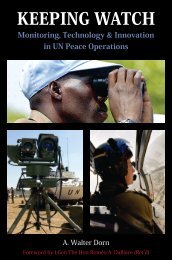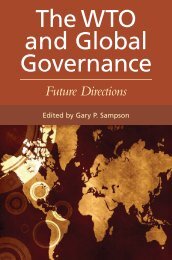Sample Chapter - United Nations University
Sample Chapter - United Nations University
Sample Chapter - United Nations University
Create successful ePaper yourself
Turn your PDF publications into a flip-book with our unique Google optimized e-Paper software.
THE RELEVANCE OF ECOSYSTEMS FOR DRR 7<br />
(2005–2015): Building the Resilience of <strong>Nations</strong> and Communities to Disasters”,<br />
which emanated from the World Conference on Disaster Reduction<br />
held in 2005 in Kobe, Hyogo, Japan and which was subsequently<br />
adopted by the General Assembly of the <strong>United</strong> <strong>Nations</strong> (A/RES/60/1952)<br />
in January 2006. The Indian Ocean tsunami also focused global attention<br />
on the environmental impacts of the disaster (including from postdisaster<br />
response and reconstruction operations) and highlighted the potential<br />
role of coastal ecosystems in providing hazard protection and<br />
mitigation. It was during this period that global environmental initiatives<br />
such as Mangroves for the Future were launched.<br />
The role of ecosystems in DRR is now well acknowledged in the International<br />
Strategy for Disaster Reduction (ISDR), which involves the<br />
international community in promoting global DRR through implementation<br />
of the Hyogo Framework for Action (HFA). The HFA has five priorities<br />
for action with respect to building resilience to disasters (UNISDR,<br />
2005). One of these priorities for action, entitled “Reduce the underlying<br />
risk factors”, recommends two key activities that have a direct link to ecosystems<br />
and ecosystem management (UNISDR, 2005: 10–11):<br />
1. Environmental and natural resource management with components<br />
that include:<br />
a. sustainable use and management of ecosystems;<br />
b. implementation of integrated environmental and natural resource<br />
management approaches that incorporate disaster risk reduction;<br />
c. linking disaster risk reduction with existing climate variability and<br />
future climate change.<br />
2. Land-use planning and other technical measures with a component on<br />
incorporating disaster risk assessment into rural development planning<br />
and management.<br />
The ISDR Global Assessment Reports on Disaster Risk Reduction in<br />
2009 and 2011 (UNISDR, 2009b, 2011) as well as the Chair Summaries of<br />
both the 2009 and 2011 Global Platforms for Disaster Risk Reduction<br />
have highlighted the importance of integrating ecosystem management as<br />
a key component in DRR strategies. The recent IPCC Special Report (2012)<br />
has subsequently echoed this message in stressing the value of investing<br />
in ecosystems as part of climate change adaptation (CCA) strategies, and<br />
ecosystem-based adaptation (EbA) has been formally endorsed by the<br />
Subsidiary Body for Scientific and Technological Advice, under the auspices<br />
of the Nairobi Work Programme of the <strong>United</strong> <strong>Nations</strong> Framework<br />
Convention on Climate Change (discussed further below). Moreover,<br />
outcomes from “Rio+20 – The Future We Want” now clearly recognize<br />
DRR as a critical component of sustainable development. At a UN General<br />
Assembly Thematic Debate on Disaster Risk Reduction in April<br />
2012 in New York, organized in preparation for the Rio+20 conference,


